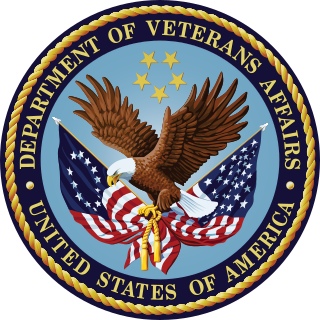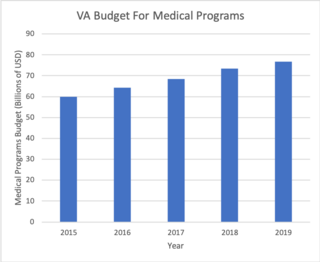
The United States Department of Veterans Affairs (VA) is a Cabinet-level executive branch department of the federal government charged with providing lifelong healthcare services to eligible military veterans at the 170 VA medical centers and outpatient clinics located throughout the country. Non-healthcare benefits include disability compensation, vocational rehabilitation, education assistance, home loans, and life insurance. The VA also provides burial and memorial benefits to eligible veterans and family members at 135 national cemeteries.

A military discharge is given when a member of the armed forces is released from their obligation to serve. Each country's military has different types of discharge. They are generally based on whether the persons completed their training and then fully and satisfactorily completed their term of service. Other types of discharge are based on factors such as the quality of their service, whether their service had to be ended prematurely due to humanitarian or medical reasons, whether they had been found to have drug or alcohol dependency issues and whether they were complying with treatment and counseling, and whether they had demerits or punishments for infractions or were convicted of any crimes. These factors affect whether they will be asked or allowed to re-enlist and whether they qualify for benefits after their discharge.

The Veterans Health Administration (VHA) is the component of the United States Department of Veterans Affairs (VA) led by the Under Secretary of Veterans Affairs for Health that implements the healthcare program of the VA through a nationalized healthcare service in the United States, providing healthcare and healthcare-adjacent services to veterans through the administration and operation of 146 VA Medical Centers (VAMC) with integrated outpatient clinics, 772 Community Based Outpatient Clinics (CBOC), and 134 VA Community Living Centers Programs. It is the largest division in the department, and second largest in the entire federal government, employing over 350,000 employees. All VA hospitals, clinics and medical centers are owned by and operated by the Department of Veterans Affairs, and all of the staff employed in VA hospitals are federal employees. Because of this, veterans that qualify for VHA healthcare do not pay premiums or deductibles for their healthcare but may have to make copayments depending on the medical procedure. VHA is not a part of the US Department of Defense Military Health System.
The Veterans Benefits Administration (VBA) under the US Department of Veterans Affairs (VA) provides a wide variety of benefits to retired or separated United States armed forces personnel and their dependents or survivors. Through the VA, Veterans can receive educational assistance, healthcare, assisted living, home loans, insurance, and burial and memorial services. The VA also provides compensation to disabled veterans who suffer from a medical disorder or injury that was incurred in, or aggravated by, their military service, and which causes social and occupational impairment. Many U.S. states also offer disability benefits for veterans.
A VA loan is a mortgage loan in the United States guaranteed by the United States Department of Veterans Affairs (VA). The program is for American veterans, military members currently serving in the U.S. military, reservists and select surviving spouses and can be used to purchase single-family homes, condominiums, multi-unit properties, manufactured homes and new construction. The VA does not originate loans, but sets the rules for who may qualify, issues minimum guidelines and requirements under which mortgages may be offered and financially guarantees loans that qualify under the program.

The Veterans Benefits Administration (VBA) is an agency of the U.S. Department of Veterans Affairs. It is responsible for administering the department's programs that provide financial and other forms of assistance to veterans, their dependents, and survivors. Major benefits include veterans' compensation, veterans' pension, survivors' benefits, rehabilitation and employment assistance, education assistance, home loan guaranties, and life insurance coverage.
The Reserve Educational Assistance Program (REAP) was an education program for American students that was established as a part of the Ronald W. Reagan National Defense Authorization Act for Fiscal Year 2005.

The Disabled American Veterans (DAV) is an organization created in 1920 by World War I veterans for disabled military veterans of the United States Armed Forces that helps them and their families through various means. It was issued a federal charter by Congress in 1932. It currently has over 1 million members. As a 501(c)(4) social welfare organization, it is outside the purview of – and therefore not rated by – Charity Navigator. DAV's Employer Identification Number (EIN) is 31–0263158.

Iraq and Afghanistan Veterans of America (IAVA), is a nonprofit 501(c)(3) veterans organization founded by Paul Rieckhoff, an American writer, social entrepreneur, advocate, activist and veteran of the United States Army and the Iraq War. He served as an Army First Lieutenant and infantry rifle platoon leader in Iraq from 2003 through 2004. Rieckhoff was released from the Army National Guard in 2007.

A veteran's pension or "wartime pension" is a pension for veterans of the United States Armed Forces, who served in the military but did not qualify for military retired pay from the Armed Forces. It was established by the United States Congress and given to veterans who meet the eligibility requirements. Along with payments, they are also given additional benefits depending on their eligibility and needs.

The Post-9/11 Veterans Educational Assistance Act of 2008 is Title V of the Supplemental Appropriations Act of 2008, Pub. L.Tooltip Act of Congress#Public law, private law, designation 110–252 (text)(PDF), H.R. 2642, an Act of Congress which became law on June 30, 2008. The act amended Part III of Title 38, United States Code to include a new Chapter 33, which expands the educational benefits for military veterans who have served since September 11, 2001. At various times the new education benefits have been referred to as the Post-9/11 GI Bill, the 21st Century G.I. Bill of Rights, or the Webb G.I. Bill, with many current references calling it simply the new G.I. Bill. President George W. Bush signed H.R. 2642 into law on June 30, 2008.
Military dependents are the spouse(s), children, and possibly other familial relationship categories of a sponsoring military member for purposes of pay as well as special benefits, privileges and rights. This generic category is enumerated in great detail for U.S. military members.
Disability benefits are a form of financial assistance or welfare designed to support disabled individuals who cannot work due to a chronic illness, disease or injury. Disability benefits are typically provided through various sources, including government programs, group disability insurance provided by employers or associations or private insurance policies typically purchased through a licensed insurance agent or broker, or directly from an insurance company.
In July 2008 the Post-9/11 GI Bill was signed into law, creating a new robust education benefits program rivaling the WWII Era GI Bill of Rights. The new Post 9/11 GI Bill, which went into effect on August 1, 2009, provides education benefits for service members who served on active duty for 90 or more days since September 10, 2001. These benefits are tiered based on the number of days served on active duty, creating a benefit package that gives current and previously activated National Guard and Reserve members the same benefits as active duty servicemembers.

The G.I. Bill Tuition Fairness Act of 2013 is a bill that would require colleges to charge veterans the in-state tuition rates regardless of whether they meet the residency requirement. The bill also makes several other changes related to veterans benefits, such as extending the time period during which veterans are eligible for job training. The bill passed the House of Representatives on February 4, 2014 during the 113th United States Congress.

United States military veteran suicide is an ongoing phenomenon regarding the high rate of suicide among U.S. military veterans in comparison to the general civilian public. A focus on preventing veteran suicide began in 1958 with the opening of the first suicide prevention center in the United States. During the mid-1990s, a paradigm shift in addressing veteran suicide occurred with the development of a national strategy which included several Congressional Resolutions. More advancements were made in 2007, when the Joshua Omvig Veterans Suicide Prevention Act created a comprehensive program including outreach at each Veterans Affairs Office (VA) and the implementation of a 24-hour crisis hotline. PTSD, depression, and combat-related guilt in veterans are often related to suicide as it can be difficult for veterans to transition to civilian life.
The Transition Assistance Program (TAP) is a U.S. Department of Defense (DoD) led program that provides information and training to ensure service members transitioning from active-duty are prepared for their next step in life - whether pursuing additional education, finding a job in the public or private sector, or starting their own business.
The Harry W. Colmery Veterans Educational Assistance Act of 2017, commonly known as the "Forever GI Bill", eliminated the 15-year use-it-or-lose-it constraint associated with the Post-9/11 GI Bill education benefit. The updated bill was created with the intent of improving previous versions of the bill and the Reserve Educational Assistance Program (REAP) which is now defunct. The bill, called the Harry W. Colmery Veterans Education Assistance Act of 2017, flew through both the House of Representatives and the Senate in the span of three weeks, passing both by unanimous votes. After the Senate's vote, the bill was signed into law by President Donald Trump.
DOD Tuition Assistance is a US Department of Defense (DOD) program that fund higher education programming for US military servicemembers who wish to attend college before their service obligation ends. Currently, DOD TA funds servicemember's college tuition and fees, not to exceed $250 per semester credit hour or $166 per quarter credit hour and not to exceed $4,500 per fiscal year, Oct. 1 through Sept. 30. In 2019, DOD spent more than $492 million on the program that year and about 220,000 troops used the benefits.
Educational assistance benefits are employee benefits that allow workers to participate in educational programs for free or at a reduced cost. These benefits are administered through education assistance programs. Education assistance programs are used by corporations to recruit, retain, and retrain employees and to increase goodwill with former employees and the public. They also serve as a corporate tax break.












